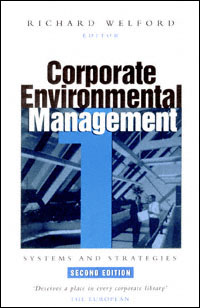Cover

| title | : | Corporate Environmental Management 1 : Systems and Strategies |
| author | : | Welford, Richard |
| publisher | : | Earthscan Ltd. |
| isbn10 | asin | : | 1853835595 |
| print isbn13 | : | 9781853835599 |
| ebook isbn13 | : | 9780585390536 |
| language | : | English |
| subject | Industrial management--Environmental aspects. , Environmental management. |
| publication date | : | 1998 |
| lcc | : | HD28.W45 1998eb |
| ddc | : | 658.408 |
| subject | : | Industrial management--Environmental aspects. , Environmental management. |
Page i
Corporate Environmental Management 1
Page ii
This page intentionally left blank
Page iii
Corporate Environmental Management 1
Systems and Strategies
S E C O N D E D I T I O N
Edited by Richard Welford
E A R T H S C A N
Earthscan Publications Ltd, London
Page iv
First published in the UK in 1996 by Earthscan Publications Limited
Revised edition first published in the UK in 1998 by Earthscan Publications Ltd
Copyright Richard Welford, 1996, 1998
All rights reserved
A catalogue record for this book is available from the British Library
ISBN: 1 85383 559 5 paperback
1 85383 560 9 hardback
Typesetting and page design by PCS Mapping & DTP, Newcastle upon Tyne
Printed and bound by Biddles Ltd, Guildford and Kings Lynn
Cover design by Andrew Corbett
For a full list of publications please contact:
Earthscan Publications Limited
120 Pentonville Road
London N1 9JN
Tel: (0171) 278 0433
Fax: (0171) 278 1142
Email: earthinfo@earthscan.co.uk
WWW: http://www.earthscan.co.uk
Earthscan is an editorially independent subsidiary of Kogan Page Limited and publishes in association with WWF-UK and the International Institute for Environment and Development
This book is printed on elemental chlorine free paper
Page v
Contents
Preface to the second edition | vii |
About the contributors | ix |
Part 1: The Context of Corporate Environmental Management |
| 1. | Environmental Issues and Corporate Environmental Management | 1 |
Richard Welford |
| 2. | Corporate Strategy, Competitiveness and the Environment | 13 |
Richard Welford |
Part 2: The Tools of Corporate Environmental Management |
| 3. | Environmental Management Systems | 37 |
Alan Netherwood |
| 4. | The Standardization of Environmental Management Systems: ISO14001, ISO14004 and EMAS | 61 |
Richard Starkey |
| 5. | Environmental Policies | 90 |
Michael Brophy |
| 6. | Environmental Guidelines and Charters | 102 |
Michael Brophy |
| 7. | Environmental Auditing | 116 |
Richard Welford |
| 8. | Life Cycle Assessment | 138 |
Richard Welford |
| 9. | Measuring Environmental Performance | 148 |
C William Young |
| 10. | Environmental Reporting | 175 |
Michael Brophy and Richard Starkey |
Part 3: Wider Applications of the Systems Based Approach |
| 11. | The EMS in the SME | 199 |
Donal O'Laoire and Richard Welford |
| 12. | Local Economic Development and Environmental Management: A Systems Approach | 210 |
Richard Welford |
| 13. | The Role of Environmental Management Systems in Local Government | 221 |
Alan Netherwood and Mark Shayler |
| 14. | Beyond Environmentalism and Towards the Sustainable Organization | 237 |
Richard Welford and David Jones |
|
Appendix | |
List of acronyms and abbreviations | |
Index | |
Page vi
This page intentionally left blank
Page vii
Preface to the second edition
The second edition of this book updates each chapter to make it even more useful to managers, students and researchers. Like the first edition, it shows how business (and other institutions) can improve their environmental performance. The environment is a pressing issue and every person, every organization and every institution has an obligation and duty to consider ways to protect it and reverse the damage done to it over the past decades. This book examines the way in which business organizations can play their part in what has to be a concerted and international effort. However, in a modern pluralist society, businesses (and particularly big businesses) are granted large amounts of power. Along with other powerful institutions we should expect them to take a stance: to educate and lead workers and consumers rather than respond to their rather weak market signals.
With that in mind, this is very much a how to do book, in that it tries to identify best practice, examines the key tools within the framework of corporate environmental management and provides the reader with references for additional reading. Where possible checklists, explanatory diagrams and summary charts have been provided to make the book accessible and useful. While we have not been uncritical about many of the developments in the field of corporate environmental management, it is intended that this book will be helpful to both students of the subject and practitioners in the field.
The book is divided into three (unequal) parts. The first part (Chapters 1 and 2) examines the general context of environmental management by considering the main drivers towards environmentalism and links between strategic management, competitiveness and environmental performance. Part 2 looks at the tools of corporate environmental management. In a detailed, critical and updated examination of environmental management systems and standards, environmental policies, guidelines and charters, environmental auditing, life cycle assessment, the measurement of environmental performance, and environmental reporting, this part of the book outlines, explains and examines the building blocks for success. This is all achieved within the framework of the systems based approach. Part 3 of the book takes the systems based approach a stage further in examining the case of small and medium enterprises and the management of local economic development from a local authority stance. The final chapter extends this systems based approach to a business based agenda for sustainable development.
Next page






